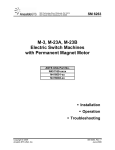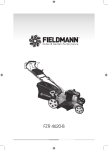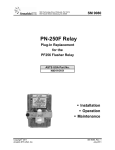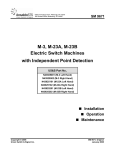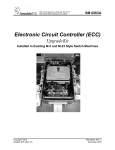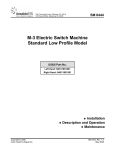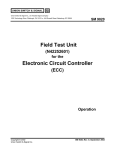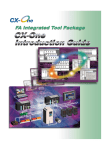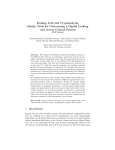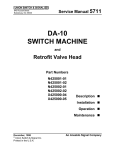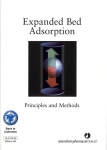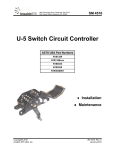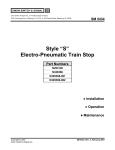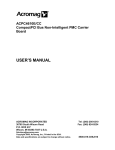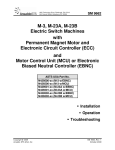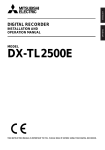Download M-3E Switch and Lock Movement
Transcript
Union Switch & Signal Inc., an Ansaldo Signal company 1000 Technology Drive, Pittsburgh, PA 15219 ● 645 Russell Street, Batesburg, SC 29006 SM 9194 M-3E™ Switch and Lock Movement with Electronic Circuit Controller (ECC) (PN N422550-XX ) ♦ Installation ♦ Operation ♦ Maintenance Copyright © 2004 Union Switch & Signal Inc. Original, October 2004 Proprietary Notice This document and its contents are the property of Union Switch & Signal Inc. hereinafter US&S). This document has been furnished to you on the following conditions: no right or license under any patents or any other proprietary right in respect of this document or its content is given or waived in supplying this document. This document or its content are not to be used or treated in any manner inconsistent with the rights of US&S, or to its detriment, and are not to be copied, reproduced, disclosed to others, or disposed of except with the prior written consent of US&S. Important Notice US&S constantly strives to improve our products and keep our customers apprised of changes in technology. Following the recommendations contained in the attached service manual will provide our customers with optimum operational reliability. The data contained herein purports solely to describe the product, and does not create any warranties. Within the scope of the attached manual, it is impossible to take into account every eventuality that may arise with technical equipment in service. Please consult your local US&S sales representative in the event of any irregularities with our product. We expressly disclaim liability resulting from any improper handling or use of our equipment, even if these instructions contain no specific indication in this respect. We strongly recommend that only approved US&S spare parts be used as replacements. SM 9194, Original, October 2004 i REVISION HISTORY Revision History Rev. Date Nature of Revision Original October 2004 Original Issue FCC PART 15 COMPLIANCE This equipment has been tested and found to comply with the limits for a Class A digital device, pursuant to Part 15 Rules. These limits are designed to provide reasonable protection against harmful interference when the equipment is operated in a commercial environment. This equipment generates, uses, and can radiate radio frequency energy and, if not installed and used in accordance with this instruction manual, may cause harmful interference to radio communications. Operation of this equipment in a residential area is likely to cause harmful interference in which case the user will be required to correct the interference at his own expense. ii SM 9194, Original, October 2004 TABLE OF CONTENTS Table of Contents 1 Introduction................................................................................................................................................... 1-1 1.1 General .................................................................................................................................................... 1-1 1.2 Definitions ................................................................................................................................................ 1-2 2 Description .................................................................................................................................................... 2-1 2.1 Motor Compartment ................................................................................................................................. 2-1 2.1.1 The Transmission Box.................................................................................................................... 2-2 2.1.2 Voltage ........................................................................................................................................... 2-2 2.1.3 Cycle Counter................................................................................................................................. 2-2 2.1.4 WAGO Terminal Strip..................................................................................................................... 2-2 2.1.5 Field Cable Conduit........................................................................................................................ 2-3 2.1.6 AAR Binding Posts ......................................................................................................................... 2-3 2.2 Gearbox Compartment ............................................................................................................................ 2-4 2.2.1 Gearbox Components and Assemblies.......................................................................................... 2-4 2.3 Circuit Controller Compartment ............................................................................................................... 2-6 2.3.1 Frog Plate....................................................................................................................................... 2-6 2.3.2 Vital Locking Sensors..................................................................................................................... 2-7 2.3.3 ECC Box......................................................................................................................................... 2-7 2.3.4 Junction Box................................................................................................................................... 2-7 2.3.5 Captive Point Detection System (CPDS) ....................................................................................... 2-8 2.3.6 Point Detector Target ..................................................................................................................... 2-8 2.3.7 Linear Slides................................................................................................................................... 2-8 2.3.8 Vital Sensor Position Monitoring .................................................................................................... 2-8 2.3.9 Non-Vital Auxiliary Sensors (Optional)........................................................................................... 2-8 2.3.10 Local/Remote Request Switches (Optional) .................................................................................. 2-9 3 Operation....................................................................................................................................................... 3-1 3.1 General Overview .................................................................................................................................... 3-1 3.1.1 “Power” Operation .......................................................................................................................... 3-1 3.1.2 “Manual” Operation via the Hand-Crank ........................................................................................ 3-1 3.1.3 Main-Crank Rotation ...................................................................................................................... 3-1 3.1.4 ECC Monitoring .............................................................................................................................. 3-1 3.2 MANUAL OPERATION............................................................................................................................ 3-1 3.2.1 Hand-Crank Operation ................................................................................................................... 3-1 3.2.2 Hand-Crank Rotation...................................................................................................................... 3-1 3.3 POWER OPERATION ............................................................................................................................. 3-2 3.3.1 Power (Motor) Operation................................................................................................................ 3-2 3.3.2 Power Mode Main-Crank Rotation ................................................................................................. 3-2 3.4 ECC OPERATION AND MONITORING .................................................................................................. 3-2 3.4.1 Proximity Sensors .......................................................................................................................... 3-2 3.4.2 Vital Point and Lock Sensors ......................................................................................................... 3-2 3.4.3 Latch-Out........................................................................................................................................ 3-3 3.4.4 Auxiliary Sensors (Optional)........................................................................................................... 3-3 3.4.5 Manual Operation Motor-Cutoff Protection .................................................................................... 3-4 3.5 ECC DIAGNOSTIC INFORMATION........................................................................................................ 3-4 3.5.1 LEDs............................................................................................................................................... 3-4 3.5.2 Vital Sensor Monitoring and Led Diagnostic Representation ........................................................ 3-4 3.5.3 Diagnostic Modes of Dual-Colored LEDs ...................................................................................... 3-5 SM 9194, Original, October 2004 iii TABLE OF CONTENTS 4 Wiring and Motor Control ............................................................................................................................ 4-1 4.1 WAGO Terminal strip Connections.......................................................................................................... 4-1 4.1.1 Terminals 1 and 3: Two-Wire, Bipolar Indication Output Circuit .................................................... 4-1 4.1.2 Terminals 4, 6, 7, and 9: Four-Wire Indication Output Circuit........................................................ 4-1 4.1.3 Terminals 10, 12, 13 and 15: Indication Input................................................................................ 4-1 4.1.4 Wayside Battery Connections ........................................................................................................ 4-2 4.1.5 Bipolar Auxiliary Sensor Output ..................................................................................................... 4-2 4.1.6 Local/Remote Request Switch Option ........................................................................................... 4-2 4.1.7 Motor Control Unit and Cycle Counter Termination ....................................................................... 4-3 4.1.8 Motor Cutout Circuits Termination Points ...................................................................................... 4-3 4.1.9 MCU Test Procedure...................................................................................................................... 4-3 4.2 AAR Terminal Post Connections ............................................................................................................. 4-4 4.3 Sensor Identification and Termination in the Junction Box...................................................................... 4-4 4.4 Three- and Five-Wire Control Conversion to Two-Wire Control.............................................................. 4-5 5 Installation..................................................................................................................................................... 5-1 5.1 Component Conversion ........................................................................................................................... 5-1 5.1.1 Circuit Controller Conversion ......................................................................................................... 5-1 5.1.2 Operating Bar Conversion.............................................................................................................. 5-2 5.2 M-3E Mounting Details............................................................................................................................. 5-2 5.3 Field Installation of Machine .................................................................................................................... 5-2 5.3.1 Lifting and Handling the M-3E........................................................................................................ 5-2 5.3.2 Placing the M-3E on the Ties ......................................................................................................... 5-3 5.4 Junction Box Jumper Configuration ......................................................................................................... 5-4 5.4.1 RHPC/LHPC Jumpers.................................................................................................................... 5-4 5.4.2 Latch-Out Jumper Configuration .................................................................................................... 5-5 5.4.3 Changing the Jumper Configurations............................................................................................. 5-5 5.5 ECC Power and Indications Set-up ......................................................................................................... 5-5 5.5.1 Single Machine Indication .............................................................................................................. 5-5 5.5.2 Multiple Machine Applications........................................................................................................ 5-5 5.5.3 Point Detector Sensor Gap Adjustment ......................................................................................... 5-6 5.6 Operating Rod Adjustment....................................................................................................................... 5-6 5.7 Point Detector Linear Slide Adjustment ................................................................................................... 5-6 5.8 Lock Rod Adjustment............................................................................................................................... 5-7 5.9 Final Inspection and Testing After Installation ......................................................................................... 5-7 6 Periodic Maintenance................................................................................................................................... 6-1 6.1 Required Tools......................................................................................................................................... 6-1 6.2 Lubrication................................................................................................................................................ 6-1 7 Troubleshooting ........................................................................................................................................... 7-1 8 Parts List ....................................................................................................................................................... 8-1 8.1 M-3E Switch Machine (N422550-XX) ...................................................................................................... 8-1 8.2 N422550-XX Switch Machine LHNC (189-1) (Figure 8-1 - Figure 8-4) ................................................... 8-1 8.3 N42205101 M-3E Transmission Assembly (Figure 8-5)........................................................................ 8-10 8.4 N42280201 M-3E Gearbox Assembly (Figure 8-6) ............................................................................... 8-12 8.5 M-3E Motor Assembly (N42200201) (Figure 8-7).................................................................................. 8-14 9 Rail Team and Technical Support............................................................................................................... 9-1 iv SM 9194, Original, October 2004 TABLE OF CONTENTS List of Figures Figure Figure 1-1 Figure 1-2 Figure 2-1 Figure 2-2 Figure 2-3 Figure 2-4 Figure 2-5 Figure 2-6 Figure 2-7 Figure 2-8 Figure 4-1 Figure 4-2 Figure 4-3 Figure 5-1 Figure 5-2 Figure 8-1 Figure 8-2 Figure 8-3 Figure 8-4 Figure 8-5 Figure 8-6 Figure 8-7 Page - M-3E Switch Machine.....................................................................................................................1-1 Right Hand and Left Hand Switch Machines..................................................................................1-3 M-3E Switch Machine Compartments............................................................................................2-1 Detailed View of the Motor Compartment Unit...............................................................................2-3 Detailed View of Transmission Box................................................................................................2-4 Detailed View of Gearbox...............................................................................................................2-5 Top View of Gear Box ....................................................................................................................2-6 Controller Compartment .................................................................................................................2-9 Controller Compartment with Sensor View ..................................................................................2-10 M-3E ECC System Block Diagram...............................................................................................2-11 Top View-Controller Compartment.................................................................................................4-5 Wiring Changes from 3-Wire and 5-Wire to 2-Wire Motor Control.................................................4-6 Internal Wiring Diagram..................................................................................................................4-7 M-3E Proper Lifting Illustration .......................................................................................................5-3 Sensor Gap Definition ....................................................................................................................5-6 M-3E Switch Machine (N422550-XX), Left Hand Unit (Sheet 1). ..................................................8-6 M-3E Switch Machine (N422550-XX), Left Hand Unit (Sheet 2). ..................................................8-7 M-3E Switch Machine (N422550-XX), Left Hand Unit (Sheet 3). ..................................................8-8 M-3E Circuit Controller ...................................................................................................................8-9 M-3E Transmission Assembly (N42205101)................................................................................8-11 M-3E Gearbox Assembly (N42280201) .......................................................................................8-13 M-3E Motor Assembly (N42200201)............................................................................................8-15 List of Tables Table Table 3-1 Table 6-1 Table 7-1 Table 8-1 Table 8-2 Table 8-3 Table 8-4 Table 8-5 - Page Diagnostics ......................................................................................................................................3-5 Required Tools ................................................................................................................................6-1 Troubleshooting Guide ....................................................................................................................7-1 Specialty Notes for the M-3E Switch Machine ................................................................................8-1 Parts List for the N422550-XX Switch Machine ..............................................................................8-1 Parts List for the M-3E Transmission Assembly............................................................................8-10 Parts List for the M-3E Gearbox Assembly ...................................................................................8-12 Parts List for the M-3E Motor Assembly........................................................................................8-14 SM 9194, Original, October 2004 v TABLE OF CONTENTS vi SM 9194, Original, October 2004 INTRODUCTION 1 INTRODUCTION 1.1 General Figure 1-1 - M-3E Switch Machine TM The M-3E (PN N422550-XX) (Figure 1-1) is the next generation “M” style switch machine developed by Union Switch & Signal Inc. (US&S). The design of the M-3E provides a state-of-the-art Electronic Circuit Controller (ECC); simple, mechanical, modular construction; and a lower level of required maintenance. In addition, all serviceable parts of the M-3E can be maintained with a single tool (a 3/8” or 1/2” drive ratchet with a 1” long, 3/4” socket, and a 10” extension). The M-3E provides “full locking” in the hand-crank mode. The M-3E utilizes the same basic drive train design as all other “M” style machines. This design has provided many years of reliable service. The machine is equipped with a 110 VDC permanent magnet motor. The M-3E incorporates many design improvements over the previous “M-3” style machine. These include a significantly lower vertical profile (9-3/4” overall height), an optional local/remote control capability, self-lubricating bearings, and direct interchangeability with competitor mechanisms. The ECC is a microprocessor-based controller that monitors the state of four vital point detection proximity sensors and can identify each possible sensor state (on, off, shorted, or open). The ECC uses SM 9194, Original, October 2004 1-1 INTRODUCTION two of the four vital point detection proximity sensors to detect the position of the switch points (normal or reverse) and two to detect that the machine is fully locked (normal or reverse). In addition to the vital point detection proximity sensors, the ECC provides two auxiliary sensors, which are used to predict switch failure. The auxiliary sensors are preset to detect the linear position of the switch points 1/8” offset from the normal switch obstruction gauge dimension (typically 1/4” or 3/8”). The M-3E ECC proximity sensor system is a true linear detection device with no moving parts to wear. The system requires no adjustment of the point detector bar but, using linear slides, provides internal adjustment capability of the vital point detection proximity sensors with respect to the point detector bar assembly. The Captive Point Detection System (CPDS) provides a captive point detector bar and target combination that accurately reports the true displacement of the switch points. The linear slide assemblies provide simple and dependable proximity sensor adjustment with respect to the ferrous metal target. The ECC provides advanced diagnostics for identifying the current state of the machine and the indication state of an adjacent (daisy-chained) machine. The diagnostics verify the delivery of indication power and auxiliary indication power to the wayside, as well as provide information on motor power availability and the state of the latch-out function. There are no mechanical contacts within the M-3E. All indication and motor circuits are controlled with solid-state equipment. Motor cutout during manual operation is achieved with one proximity sensor to indicate the position of the hand crank cover access door (actuated when the hand-crank cover door is opened). 1.2 Definitions AAR Association of American Railroads - Communication and Signal Section (currently known as AREMA). AMP® Registered Trademark for AMP Corporation. A.R.E.A American Railway Engineering Association. AREMA American Railway and Maintenance of Way Association (formerly known as AAR). CPDS™ Captive Point Detection System (U.S. Patent No. 6,186,448 B1). ECC US&S Electronic Circuit Controller (U.S. Patent No. 6,484,974 B1). Front of Machine The physical area of the switch machine closest to the motor. FRA Federal Railroad Administration. Full Locking Refers to the locking operation in the hand-throw mode where the slide bar completes its stroke and switch indication is obtainable. LHPC “Left Hand Point Closed” - Refers to the switch point position when the point is normally closed to the left-hand side, looking into the switch points (in the direction of the arrow shown in Figure 1-2, note that Figure 1-2 represents a RHPC application). Latch-Out Device which does not allow switch point indication to restore if the switch point moves away from the stock rail (point detection is momentarily lost). This function will only be activated if the point sensors are actuated (change state) before their corresponding locking sensors are actuated (change state). 1-2 SM 9194, Original, October 2004 INTRODUCTION Latch-Out Restoration The term latch-out restoration refers to resetting the machine to an operable switch machine indication state from a latched out condition. Left-Hand Switch The position of a switch machine designated when the machine is located on the left-hand side of the track, looking into the switch points (in the direction of the arrow shown in Figure 1-2). Linear Slides A device used to move the point detection proximity sensors in a direction parallel to the point detector bar. Locking Locking is achieved when the lock box, connected to the slide bar, enters the narrow locking notch of the lock rods and extends a minimum of 1/2” into the locking rod. MCU Motor Control Unit - High current, solid-state device used to control motor power. Non-Vital Circuit PD Any circuit with a function that does not affect the safe operation of the train. Point detector or point detection (as in “PD bar”). Point Detection Positive indication achieved when the switch points are closed adequately against the stock rail. RHPC “Right Hand Point Closed” - Refers to the switch point position when the point is normally closed to the right-hand side of the track, looking into the switch points in the direction of the arrow shown in Figure 1-2. Rear of Machine Physical area of the machine furthest from the motor. Right Hand Switch Position of a switch machine designated when the machine is located on the right-hand side of the track, looking into the switch points in the direction of the arrow shown in Figure 1-2. Switch Machine Indication Vital determination of a safe switch configuration due to positive indication that the switch machine has properly thrown, locked, and detected switch point closure. Switch and Lock Movement and/or Mainline Switch Machine Device, the complete movement of which performs the three operations of unlocking, operating, and locking a switch, movable point frog, or derail. LEFT- HAND RIGHT- HAND Figure 1-2 - Right Hand and Left Hand Switch Machines SM 9194, Original, October 2004 1-3 INTRODUCTION Vital Circuit Any circuit with a function that affects the safe operation of the train. WAGO® Registered trademark of the WAGO Corporation. WAGO Strip May also be referred as WAGO Terminal. 1-4 SM 9194, Original, October 2004 DESCRIPTION 2 DESCRIPTION The M-3E Switch Machine is divided into three distinct compartments: the motor compartment, the gearbox compartment, and the circuit controller compartment as illustrated in Figure 2-1. CIRCUIT CONTROLLER COMPARTMENT GEARBOX COMPARTMENT MOTOR COMPARTMENT Figure 2-1 - M-3E Switch Machine Compartments 2.1 Motor Compartment The motor compartment (Figure 2-2 and Figure 2-3) houses the modular transmission box, the solidstate motor control unit (MCU), the cycle counter, the WAGO terminal strip (where indication and battery field wires are connected), the field cable conduit entrance, and AAR binding posts (for motor control and motor compartment heater wire termination). The MCU contains solid-state electronics to handle the activation and deactivation of motor power. (Refer to Figure 2-8 for the system block diagram.) SM 9194, Original, October 2004 2-1 DESCRIPTION 2.1.1 The Transmission Box The modular transmission box incorporates a face-mount motor (110 VDC), reduction gears, and a friction clutch assembly. The transmission box module is sealed with a maintenance-free lubricant (US&S P/N: A041750-0001) and houses the drive train reduction gears, which are available in (and can be converted to) 189:1 and 360:1 gear ratios. The first reduction gear of each ratio combination is equipped with a bevel gear, which interacts with the hand-crank bevel gear providing hand-crank capability (with a 2:1 advantage over existing M-3 designs). Approximately 33 rotations of the handcrank are required to move the machine from one extreme position to the next. 2.1.1.1 Hand-crank Plunger Mechanism The transmission box is also equipped with a hand-crank door mechanism, which is monitored by a motor cutout proximity sensor. When the hand crank cover door is opened to allow insertion of the hand-crank, the normally ON sensor turns OFF, disabling motor power within the machine (indicated by the illumination of the red Motor Disabled LED on the ECC) and turning OFF all switch indication outputs. 2.1.2 Voltage The MCU is available in high voltage (110VDC) configuration. 2.1.3 Cycle Counter A non-resettable cycle counter is installed in the motor compartment to assist in determining required maintenance frequency and to maintain a history of the machine’s usage. The cycle counter tallies each complete cycle of the switch machine (i.e., the counter increments each time the machine completes a cycle from normal to reverse and back to normal again). The counter cannot be reset so the operational history of the machine is preserved. 2.1.4 WAGO Terminal Strip Note All 16 of the gas arrestors (US&S PN: J7927360109) do not electrically connect the ECC or MCU I/O circuitry to the ground terminals. The gas arrestors are normally open to the I/O lines that they protect and will fire upon a local lightning strike, bringing the surge currents to the ground terminals instead of into the machine’s internal circuitry. The arrestors can be fired multiple times, at high potentials, before their integrity is degraded. The WAGO terminal strip is the central termination point for ECC power and indication circuit connections. It is where all field cables and wayside signal battery for the ECC are terminated. The ECC requires continuous 12 VDC battery feed from the wayside (800mA continuous current draw max.) There are fourteen (14) gas arrestors mounted on the WAGO terminals to protect the ECC I/O lines from external lightning and surge potentials. The ECC box is connected to the WAGO terminal strip in the motor compartment with two plugcoupled cables, TB1 and TB2. Both plug couplers are keyed differently so they cannot be interchanged on the ECC box. The terminal strip is the integration point of the ECC system where all field wires for 2-2 SM 9194, Original, October 2004 DESCRIPTION switch indication and the wayside battery feed to the ECC system. (Refer to Figure 2-8 for the system block diagram.). The WAGO terminal strip is also the termination point for the machine’s cycle counter, the local/remote request switch option, and the two motor cutout sensors for disabling motor power when manually operating the machine (by either hand-crank or the hand-throw lever). 2.1.5 Field Cable Conduit The field cable conduit entrance is designed to accept a threaded, 2-1/2” NPT connection, which can be reduced to accommodate any watertight threaded conduit application. 2.1.6 AAR Binding Posts The motor compartment is also equipped with an eight-way AAR binding post strip for field, motor power cable wires and motor control unit termination. Two of the AAR posts are strapped with a “Gold Nut” to disable motor power to the machine while allowing ECC signal battery to power the ECC for diagnostic analysis. These terminals are equipped with two (2) additional gas arrestors to protect the MCU circuitry. (Refer to Figure 2-8 for the system block diagram.) The MCU houses the electronic motor control circuitry. The circuitry turns OFF motor power at the end of each stroke only after the lock box in the machine is fully locked (through the narrow notch). HAND CRANK PLUNGER TRANSMISSION BOX 110 VDC MOTOR AAR BINDING POSTS WAGO TERMINAL BOARD CYCLE COUNTER FRICTION CLUTCH CONDUIT ENTRANCE2-1/2” NPT THREAD MOTOR CUTOUT UNIT (MCU) Figure 2-2 - Detailed View of the Motor Compartment Unit SM 9194, Original, October 2004 2-3 DESCRIPTION TRANSMISSION BOX COVER HAND CRANK PLUNGER TRANSMISSION BOX COVER PLATE HAND CRANK INSERTION POINT HAND CRANK MOTOR CUTOUT PROXIMITY SENSOR BRACKET WORM SHAFT DRIVE TRANSMISSION BOX HAND CRANK MOTOR CUTOUT PROXIMITY SENSOR Figure 2-3 - Detailed View of Transmission Box 2.2 Gearbox Compartment The gearbox compartment (Figure 2-4 and Figure 2-5) houses the worm shaft/worm gear drive combination, the main-crank, top bearing plate, and main crank spacer. 2.2.1 Gearbox Components and Assemblies The worm gear-based drive train and main-crank configuration of the M-3E is based on the design of the M-3. While the new transmission box itself is now modular in design, the worm shaft/worm gear ratio design is identical to that of the M-3. The 220-degree rotation of the main-crank in the gearbox produces the timed operation of the operating bar and slide bar to throw and lock/unlock the machine, accordingly. 2-4 SM 9194, Original, October 2004 DESCRIPTION MAIN CRANK T-PLATE CAST GEARBOX HOUSING Figure 2-4 - Detailed View of Gearbox SM 9194, Original, October 2004 2-5 DESCRIPTION REAR PILLOW BLOCK WORM SHAFT/ WORM GEAR DRIVE T-PLATE FRONT PILLOW BLOCK Figure 2-5 - Top View of Gear Box 2.3 Circuit Controller Compartment The circuit compartment (Figure 2-6 and Figure 2-7) houses the frog plate (controller frame), ECC, junction box, captive point detector system (CPDS), linear slides, local/remote control switches (optional), four vital proximity sensors, and two non-vital auxiliary sensors (optional). See Figure 2-8 for ECC system block diagram and Section 3.1 for a detailed description of the ECC system integration. CAUTION Excessive heat may damage the ECC. Heaters should not be placed in the circuit controller compartment. 2.3.1 Frog Plate The frog plate is used as the base frame to mount the CPDS, linear slides, ECC box, junction box and the vital proximity sensors. The modular frog plate can be replaced completely if damaged. 2-6 SM 9194, Original, October 2004 DESCRIPTION 2.3.2 Vital Locking Sensors Two vital locking sensors are threaded into the frog plate casting and are used to determine the linear position of the lock box. The locking sensors are in a fixed location to ensure compliance to FRA Rule 236.330. The locking sensors are also used to control the motor control unit (MCU) via the ECC to turn off motor power only after the lock dog on the lock box has fully engaged and extended beyond the narrow notch of the lock rod. 2.3.3 ECC Box The ECC box houses a microprocessor and conditional power supply board, which are used to determine the state of the switch machine and provide switch indication power to the outputs, respectively. The ECC provides advanced diagnostics to quickly determine the state of the machine and adjacent (daisy-chained) switch machine indication circuits. There is a momentary latch-out restoration pushbutton on the front face of the ECC to manually restore a latch-out condition when the ECC is configured in the manual or automatic restoration modes (via the jumper in the junction box). 2.3.3.1 AMP® Plug Couplers The ECC uses three AMP® plug couplers. One coupler (designated as JB1) connects the ECC to the junction box. The other two couplers (designated TB1 and TB2) connect the two 10-conductor cables, that run through the PVC conduit underneath the gearbox housing, and are terminated at the terminal strip in the motor compartment. The ECC is a sealed, non-serviceable unit and can be replaced simply by removing the four 1/2”-bolts securing the ECC adapter plate (attached to the bottom of the ECC box) and unplugging the three plug couplers. (See Figure 2-8 for ECC system block diagram.) 2.3.4 Junction Box The junction box, mounted directly to the end of the frog plate (furthest from the gearbox), provides termination for six proximity sensors through a six-way cable grip. In addition, the junction box is equipped with two jumper configurations for determining the “normally closed” switch point (RHPC or LHPC) and latch-out options (manual, automatic, or disabled). 2.3.4.1 Jumper Configurations (See Figure 3-8) The junction box, with two jumper configurations, provides the ECC box with information for determining which point is normally closed [left-hand point closed (LHPC) or right-hand point closed (RHPC)] and which type of latch-out configuration is selected (manual restoration, automatic restoration or latch-out completely disabled). Manual latch-out restoration is achieved by depressing the pushbutton on the ECC box for one second and releasing. Note that a latch-out condition will only restore if all four vital proximity sensors indicate that the machine is fully locked and detected in one position. 2.3.4.2 Vital and Non-Vital Sensors (Optional) The junction box is where the four vital sensors (two for point detection and two for locking detection) and two non-vital sensors are terminated via a six-way cable grip into the junction box. This termination method allows for convenient replacement of any individual sensor in the system. See Figure 2-8 for ECC system block diagram. SM 9194, Original, October 2004 2-7 DESCRIPTION 2.3.5 Captive Point Detection System (CPDS) The captive point detection system (CPDS) consists of a self-lubricating bearing sleeve, which holds captivative the point detector bar across the entire width of the machine. By not extending the point detector bar outside the field side of the machine, we eliminate any pinch-point safety hazard with the hand-throw lever (which is now lower, due to the reduced profile of the gearbox). 2.3.6 Point Detector Target Attached to the captive point detector bar is a ferrous metal, radial target used to activate the four vital point detection proximity sensors with respect to switch point position. The target is fastened to the point detector bar with a 1/4”-20 socket head cap screw that stays captive by the sleeve. The end of the point detector bar extending outside of the machine on the trackside is rigidly connected to the point detector connecting rod/lug. The point detector bars are available with two connecting end styles; 1”-8 threaded end for use with a drop lug and a 5/8” pin machined-end for use with a clevis lug. 2.3.7 Linear Slides The linear slides are used to secure and provide adjustment of the vital point detection proximity sensors with respect to the point detector target on the point detector bar. There are two linear slides, one for each position of the switch point. Each linear slide is equipped with a vital proximity sensor (18mm diameter) and a non-vital, auxiliary proximity sensor (8mm diameter). Adjustment of the linear slides is accomplished by loosening the 1/2” bolt at the top of the slide and rotating the thumb wheels accordingly. The thumb wheels rotate a 1/2”-20 threaded rod; therefore, one full rotation of the thumb wheels results in a 0.050” linear displacement of the proximity sensors, parallel to the point detector bar. 2.3.8 Vital Sensor Position Monitoring The state (ON, OFF, SHORTED or OPEN) of each vital sensor is continually monitored by the ECC processor every 50 milliseconds. The vital sensor’s position is adjusted with respect to the point detector target’s position, to detect a defined linear change in position of the target (for example: a 1/4” obstruction in the switch point). 2.3.9 Non-Vital Auxiliary Sensors (Optional) Like the vital sensors, the non-vital auxiliary sensors also monitor the point detector target’s position, but their sensing range is mechanically offset by approximately 1/8”. This enables the auxiliary sensors to detect target movement before vital sensor detection. When the auxiliary sensors are no longer sensing the target, a normally ON auxiliary bipolar output on the WAGO terminal strip becomes deenergized. This feature is used to predict switch failures. As an example, if the vital sensor is adjusted to detect a 1/4” obstruction in the switch points, the target must be displaced by that same distance before the vital sensor changes from the ON to the OFF state. The non-vital sensor, however, changes from the ON to the OFF state after an approximate 1/8” displacement in linear target position. This can be used to indicate that the machine moved marginally and is on the verge of failure (i.e., the switch points have moved due to temperature or the point is still closing but is being gradually obstructed by an element such as sand, ice, etc.). 2-8 SM 9194, Original, October 2004 DESCRIPTION 2.3.10 Local/Remote Request Switches (Optional) The local/remote request switches are used to locally operate the machine, similar to that of a wayside local control panel. One toggle switch is used to take local or remote control and the other toggle switch is used to cycle the machine from normal to reverse and back, in the local control mode of operation. OPTIONAL LOCAL/REMOTE CONTROL SWITCHES JUNCTION BOX PROXIMITY SENSORS CAPTIVE POINT DETECTION SYSTEM (CPDS) FROG PLATE ECC ASSEMBLY Figure 2-6 - Controller Compartment SM 9194, Original, October 2004 2-9 DESCRIPTION NON-VITAL PD SENSOR - AUX 2 POINT DETECTOR TARGET POINT DETECTOR BAR CAPTIVE POINT DETECTOR SLEEVE VITAL PD SENSOR - PS2 VITAL LOCKING SENSOR - LS1 JUNCTION BOX NON-VITAL PD SENSOR - AUX 1 FROG PLATE LOCK BOX VITAL PD SENSOR - PS1 VITAL LOCKING SENSOR - LS2 Figure 2-7 - Controller Compartment with Sensor View 2-10 SM 9194, Original, October 2004 DESCRIPTION CIRCUIT CONTROLLER COMPARTMENT ECC BOX MICROPROCESSOR & POWER SUPPLY, DIAGNOSTIC LED DISPLAY + LATCH OUT RESTORATION PUSHBUTTON JUNCTION BOX SENSOR TERMINALS + LHPC/RHPC & LATCH OUT OPTION JUMPER CONFIGURATIONS LATCH OUT RESTORATION TB1 TB2 P S 1 JB1 LOCAL REMOTE REQUEST SWITCHES P S 2 VITAL POINT SENSORS L S 1 L 2 VITAL LOCKING SENSORS A U X 1 A U X 2 AUXILLIARY POINT SENSORS CYCLE COUNTER HANDCRANK TERMINAL BOARD & BINDING POSTS MOTOR CUTOUT SENSORS FOR MANUAL OPERATION MOTOR CONTROL UNIT (MCU) MOTOR FIELD CABLE AND WAYSIDE BATTERY FOR ECC MOTOR COMPARTMENT Figure 2-8 - M-3E ECC System Block Diagram SM 9194, Original, October 2004 2-11 DESCRIPTION 2-12 SM 9194, Original, October 2004 OPERATION 3 OPERATION 3.1 General Overview The M-3E can be operated with a manual hand-crank. The transmission box is equipped with a handcrank opening and motor cutout plunger for manual operation protection. The 3/4” hex crankshaft in the transmission box is designed so a standard 3/4” socket also can be used to move the mechanism. 3.1.1 “Power” Operation Under “power” operation, the worm shaft/worm gear combination is driven by a series of reduction gears powered by the motor (reduction gears can be either of two gear ratio combinations: 189:1 or 360:1). 3.1.2 “Manual” Operation via the Hand-Crank Under “manual” operation via the hand-crank, the hand-crankshaft in the transmission box drives the last reduction gear via a 1:1 bevel gear combination. The driving of the reduction gears rotates the worm shaft/worm gear combination ultimately resulting in rotation of the main-crank via the vertical clutch assembly. With all reduction gear combinations (189:1 and 360:1) the hand-crank operates on a 2:1 gear ratio to the worm shaft (i.e., two rotations of the hand-crank results in one rotation of the worm shaft). 3.1.3 Main-Crank Rotation The lobes on the top of the lower main-crank flange interact with the rollers on the slide bar, moving the slide bar linearly along the length of the machine to unlock the lock rods. Just before the slide bar stops moving, the lower hub and roller on the bottom of the main-crank flange begins to drive the operating bar. The operating bar moves through a 6” stroke, moving the switch points to the opposite position. Just before the operating bar stops moving, completing the point closure, the slide bar begins to move again to begin locking the machine in the opposite position. 3.1.4 ECC Monitoring The ECC continually monitors the state of the machine, reporting the transition of the machine from one position to the other. Switch indication circuits are OFF when the machine is in transit and the circuits are shunted for additional safety precaution. 3.2 MANUAL OPERATION 3.2.1 Hand-Crank Operation Hand-crank operation is performed by opening the hand crank cover door and inserting the hand crank onto the crankshaft. Ensure that the motor disabled LED is illuminated on the ECC and that the hand crank or socket is fully seated on the hex crankshaft prior to operating the machine manually. 3.2.2 Hand-Crank Rotation The machine will crank from one extreme, locked position to the other with approximately 33 rotations of the hand-crank with the 189:1 gear ratio. SM 9194, Original, October 2004 3-1 OPERATION 3.3 POWER OPERATION When the M-3E is powered up, moving the switch is as follows: The switch indication is turned off and the machine is unlocked. The switch is then thrown to the opposite position and locked in that position. With the machine locked and the points detected in that position, the switch indication is then turned on. 3.3.1 Power (Motor) Operation When operating the machine under power, energy is applied to the AAR binding posts 1 and 4, and the motor begins to rotate. The motor drives the reduction gears in the transmission box through either a 189:1 or 360:1 gear ratio (depending on the application). The reduction gears drive the clutch gear on the worm extension shaft and in turn rotates the worm shaft. The rotation of the worm shaft rotates the worm gear, directly driving the main-crank through the vertical clutch assembly. 3.3.2 Power Mode Main-Crank Rotation In the power mode of operation, the main-crank rotates 220 degrees from one fully locked position to the other fully locked position. 3.4 ECC OPERATION AND MONITORING The ECC system is functionally equivalent to that of the US&S N285638 circuit controller mechanism, but has no mechanical contacts or cam arrangements. The MCU emulates the motor cutout contacts from the mechanical controller in that it is continuously set up to move the machine to the opposite direction when in the full Normal or Reverse positions. This MCU provides the same “make-beforebreak” motor control circuitry as in the existing M-3/M-23 controllers. 3.4.1 Proximity Sensors All proximity sensors used in the ECC system, vital and non-vital, are active under NORMALLY ON conditions. In other words, no logic condition of the ECC is dependent upon the point detection, locking, auxiliary or even motor cutout sensors being OFF to make a decision. The only time the OFFstate of the sensors is relevant is when determining the locked and detected position of the machine. In order for switch indication to be energized, for example, in the normal position, both the normal point and lock sensors must be ON and the reverse point and lock sensors must be OFF. 3.4.2 Vital Point and Lock Sensors The vital point and lock sensors work in predetermined pairs; and each of the two-paired sensors, one point and one lock, are linked together. In other words, in order to receive a normal switch indication output from the ECC, both the point and lock sensors for the normal position must both be energized or ON. The same is true for both point and lock sensors for the reverse position. If either one of the two paired sensors are OFF, in either switch position, the switch indication output is OFF for that position. The paired sensors are labeled PS1 & LS1 and PS2 & LS2, and work together, respectively. Which pair of sensors corresponds to the normal position is dependent upon the position of the LHPC/RHPC jumper position in the junction box. When the machine is locked and the points are detected in either the normal or reverse positions (illustrated by the point detected and point locked LEDs) and the corresponding indication input is 3-2 SM 9194, Original, October 2004 OPERATION present or energized, the indication output LED for that switch position will be illuminated on the ECC. This is a direct confirmation that indication power (~12VDC) is leaving the machine. 3.4.3 Latch-Out If the machine is locked and detected in either the normal or reverse positions and the points move 3/8 of an inch away from the stock rail, the ECC will electronically latch-out, turning OFF the indication output for that position and holding it out (in a manner depending on the latch-out jumper position in the junction box). A latch-out condition is indicated by the illumination of the RED latch-out LED on the ECC. The latch-out can be restored either manually or automatically. 3.4.3.1 Manual Latch-Out Restoration Restore the latch-out manually by pressing the momentary latch-out restoration pushbutton on the ECC for one second and releasing. This can be done in either the manual or automatic restoration modes but will only occur if the point and lock sensors are properly indicating. 3.4.3.2 Automatic Latch-Out Restoration The latch-out will be restored by moving the machine toward the opposite position until all four vital sensors are OFF and, then, by returning to the original position. This will occur only in the automatic latch-out jumper mode and only if the point and lock sensors are properly indicating. 3.4.3.3 Disabling the Latch-Out Feature The latch-out feature can also be completely disabled by placing the junction box jumper in the “disabled” latch-out position. 3.4.4 Auxiliary Sensors (Optional) The ECC also continually monitors the states of the two auxiliary sensors mounted on the linear slides above the two vital point detector sensors. The auxiliary sensors are biased toward the outside of each vital sensor by a 1/8” sensing range differential. This means that if the vital sensor is adjusted to detect a 1/4” linear displacement of the point detector bar (i.e., turn OFF), the auxiliary sensor will turn OFF after the bar has displaced approximately 1/8”. Similarly, if the vital sensor is adjusted to sense 3/8” point detector rod movement, the auxiliary sensor will turn OFF after the bar has moved approximately 1/4”. This approximate 1/8” differential provides the ability to predict a switch failure caused by sand, ice accumulation in the switch points or switch point movement resulting from extreme temperature changes, etc. The auxiliary sensors indicate that while the machine is still within the FRA guidelines for maintaining switches, the machine is on the verge of being obstructed. A normally energized bipolar output is provided on the WAGO terminal strip to be used on the wayside to notify operators or maintenance personnel that a problem is developing. SM 9194, Original, October 2004 3-3 OPERATION NOTE This adjustment should be factory set and should not have to be set in the field. Adjust the vital sensor until the “Point Detector” of the ECC LED turns on. Turn the adjusting wheel four turns so the vital sensor is farther in front of the target. At this point, turn the adjusting wheel in the opposite direction. The non-vital sensor should be set to turn off between two and three turns. This will set the non-vital sensor to turn off at approximately 1/8” as the point moves away from the stock rail. The gap between the target and the sensor is to be approximately 0.040”. 3.4.5 Manual Operation Motor-Cutoff Protection Manual operation motor-cutoff protection is provided with the use of one-8mm diameter inductive proximity sensor. The hand-crank sensor is continuously monitoring the horizontal position of the hand crank. When the plunger is retracted 1/4”, the normally ON sensor turns OFF and the ECC disables the MCU, accordingly. The plunger assembly is on the transmission box (Figure 2-3). CAUTION Although the motor cutout proximity sensors disable the motor power for manual operation, it is strongly recommended that the “Gold Nut” in the motor compartment be opened before performing work on or inside the mechanism to prevent possible injury. The “Gold Nut” will prevent the machine from throwing. 3.5 ECC DIAGNOSTIC INFORMATION 3.5.1 LEDs The ECC is equipped with a series of LEDs to indicate the current state of the switch machine. Dualcolored LEDs are provided to indicate the state of each vital point and lock sensor. Green LEDs are provided for indication input, indication output and auxiliary sensor state definition. Red LEDs are provided to determine when the motor is disabled and when the ECC is in a latched-out state. Table 3-1 describes what the ECC diagnostics represent. 3.5.2 Vital Sensor Monitoring and Led Diagnostic Representation The ECC continuously monitors the state of each vital point and lock sensor in the machine. By analyzing the current draw of the sensors, it can determine if the sensor is On, Off or Indeterminate. Indeterminate can mean the sensor is open, shorted or between the range of ON and OFF. 3-4 SM 9194, Original, October 2004 OPERATION Table 3-1 - Diagnostics Point Detected Point Locked GREEN Sensor On RED Sensor Off FLASHING RED Indeterminate GREEN Sensor On RED Sensor Off FLASHING RED Indeterminate Indication GREEN Input DARK Indication input power present from adjacent machine Indication GREEN Output DARK Switch is locked and detected/indication output is on Auxiliary Point Detected GREEN Aux. Sensor on / aux. bipolar output is on DARK Aux. Sensor off / aux. bipolar output is off RED Latched out DARK Not latched out RED Motor power disabled DARK Motor power enabled Latch-out Motor Disabled No indication power present Switch is not locked and detected/indication output is off 3.5.3 Diagnostic Modes of Dual-Colored LEDs As illustrated in Table 4-1, the dual-colored LEDs that represent the states of the vital point and lock sensors have three possible diagnostic modes: green, red, or flashing red. Green simply means the sensor is on and is detecting its specified target. Red means the sensor is off and not sensing the target. In order to definitively distinguish between an On and an Off sensor state, an indeterminate operating window is used between the two states, flashing red. As the target approaches the sensor, the sensor will change from the Off state to an Indeterminate state and then to the On state. The LED will represent this by changing from red to flashing red and then to green. During normal switch operation, this transition will not be noticeable. SM 9194, Original, October 2004 3-5 OPERATION . 3-6 SM 9194, Original, October 2004 WIRING AND MOTOR CONTROL 4 WIRING AND MOTOR CONTROL 4.1 WAGO Terminal Strip Connections Terminals 2, 5, 8, 11, 14, 18, and 22 are internally connected to the DIN rail and serve as a means by which the 14 gas lightning arrestors make contact with the base of the machine for grounding purposes (Figure 4-1). NOTE To maintain operability no other wires should be terminated to these points. 4.1.1 Terminals 1 and 3: Two-Wire, Bipolar Indication Output Circuit Terminals 1 and 3 are for field connections to a two-wire, bipolar indication output circuit. 4.1.1.1 Normal Indication Normal indication is defined as (+) on terminal 3 and (-) on terminal 1. 4.1.1.2 Reverse Indication Reverse indication is defined as (-) on terminal 3 and (+) on terminal 1. 4.1.1.3 No Output If there is no output, terminals 1 and 3 are shunted. 4.1.2 Terminals 4, 6, 7, and 9: Four-Wire Indication Output Circuit Terminals 4, 6, 7, and 9 are for field connections to a four-wire indication output circuit. 4.1.2.1 Normal Indication Normal indication is defined between terminals 7 (negative) and 9 (positive). 4.1.2.2 Reverse Indication Reverse indication is defined between terminals 4 (negative) and 6 (positive). 4.1.2.3 No Output If there is no output on the paired terminals, they are shunted. 4.1.3 Terminals 10, 12, 13 and 15: Indication Input Terminals 10, 12, 13 and 15 are for indication input field connections from an adjacent machine’s indication output circuit or can be jumpered in the application of a single machine. 4.1.3.1 Normal Indication Normal indication input is defined between terminals 13 (negative) and 15 (positive) SM 9194, Original, October 2004 4-1 WIRING AND MOTOR CONTROL 4.1.3.2 Reverse Indication Reverse indication input is defined between terminals 10 (negative) and 12 (positive). 4.1.3.3 Indication Output If the machine is used in a single machine application, the battery must be fed to the indication input circuits to provide indication output. Refer to wiring diagram illustrated in Figure 4-3 for proper jumper configuration. WARNING Four indication input jumpers are factory installed on the WAGO terminal strip and must be removed for multiple-machine applications. 4.1.4 Wayside Battery Connections Terminal 17 is used for connecting wayside battery N12. Terminal 20 is used for connecting wayside battery B12. Note that there are factory installed jumpers between paired terminals 16 and 17 and between paired terminals 19 and 20. Wayside battery can be fed to either available terminal of each pair. 4.1.5 Bipolar Auxiliary Sensor Output Terminals 21 and 23 are for field connections to the two-wire, bipolar auxiliary sensor output. 4.1.5.1 Normal Auxiliary Indication Normal auxiliary indication is defined as (+) on terminal 23 and (-) on terminal 21. 4.1.5.2 Reverse Auxiliary Indication Reverse auxiliary indication is defined as (-) on terminal 23 and (+) on terminal 21. WARNING The maintenance output is NOT VITAL and should never be used to clear signals. 4.1.6 Local/Remote Request Switch Option Terminals 20, 24, 25, and 26 are for field connections to use the local/remote request switch option. This function is beneficial, particularly when conducting monthly inspections. In order for this function to work, however, the wayside must be configured properly. The two toggle switches in the machine (L/R and N/R) interface with the local control panel, providing the ability to control the machine as though operating directly from the local control panel. Normally, the local/remote (L/R) switch is to be in the remote position. When placed in the local position, battery + is routed to terminal 26. The local control panel is thus activated to receive commands from 4-2 SM 9194, Original, October 2004 WIRING AND MOTOR CONTROL maintenance personnel at the machine. The second switch (N/R) is a center-OFF, spring-return toggle. When held in the N position, the machine is electrically driven from the wayside controller to the normal position. If the switch is released before the stroke is complete, the motor will coast to a stop. WARNING The LOCAL REQUEST will override the dispatcher’s control of the machine. It is important to return the L/R switch to the REMOTE position upon completion of maintenance to return control of the machine to the dispatcher. 4.1.7 Motor Control Unit and Cycle Counter Termination Terminals 27 through 31 are for termination of the motor control unit (MCU) and are also used to terminate the cycle counter. 4.1.7.1 Motor Control ON MOTOR FRONT and ON MOTOR REAR are used to turn off motor current at the end of the stroke. For example if the motor is turning to produce motion of the lock box toward the motor compartment (front end of the machine), both ON MOTOR FRONT and ON MOTOR REAR are +, relative to GND. When lock sensor LS2 turns ON, the ON MOTOR FRONT line switches to GND. In response, the motor controller opens the motor to the polarity of current that would continue motion in the same direction. Additionally, the counter is energized momentarily and one count is registered. Operation in the opposite direction is the same with ON MOTOR REAR switching to stop the motor; however, the counter does not respond. NOTE Normally, there should be no need to measure voltage on the WAGO terminal strip because LEDs on the ECC accurately display voltages at the strip. The one exception is if the connection to the strip is open. If there is reason to make a measurement, do not use battery (-) as a reference, the voltages on the strip are not referenced to battery: they are isolated from it. 4.1.8 Motor Cutout Circuits Termination Points Terminals 32 through 34 are the termination points for the motor cutout circuits. In an M-3E, this is the termination point for the hand-crank motor cutout proximity sensors. 4.1.9 MCU Test Procedure Perform the following test on the MCU unit to validate safe operation. 1. Open the “Gold Nut” to disconnect power from the motor. 2. Remove the field wires on terminals 1 and 3 to disconnect motor power from the house. SM 9194, Original, October 2004 4-3 WIRING AND MOTOR CONTROL 3. Connect a 100-ohm resistor or signal lamp across terminals 3 and 4. (This may not be necessary if an analog meter is being used to make subsequent measurements.) 4. Connect a voltmeter across terminals 3 and 4. 5. Connect battery (either polarity) to terminals 1 and 3. 6. The meter will read either 0 or 12 volts (if the machine is locked either normal or reverse). 7. Reverse the previous battery polarity. (If the previous reading was 12 volts it should now read 0; if the previous reading was 0 it should now read 12.) 8. Restore the polarity to achieve a 12-volt reading. 9. Lift the selector lever and confirm the reading is 0. 10. Manually crank the machine to the opposite position and confirm that the meter remains at 0. 11. Reverse battery polarity, and the meter should now read 12 volts. 4.2 AAR Terminal Post Connections There are eight AAR binding post terminals labeled 1 through 8. Terminal 1 is the termination point for the red MCU control wire, one of the two field motor control wires, and a gas tube arrestor used for lightning protection. Terminals 2 and 3 are common terminals used for grounding purposes and termination of the gas arrestors which are connected to terminals 1 and 4. Terminal 4 is the termination point for the second field motor control wire and is also used for mounting a gas tube arrestor for lightning protection. Terminal 5 is the connection point for the jumpers to Terminals 4 and 6. Terminal 6 is the termination point for the negative motor terminal. A “Gold Nut” test link is provided between Terminals 5 and 6 to disconnect motor power when performing maintenance on the machine. Terminals 7 and 8 are designated for motor compartment, heater wire termination. 4.3 Sensor Identification and Termination in the Junction Box The vital point detector sensors are designated PS1 and PS2. The vital locking sensors are designated LS1 and LS2. The auxiliary point detector sensors are designated Aux1 and Aux2. It is important to note that PS1 and LS1 always work in combination together, while PS2 and LS2 always work together as well. Refer to Figure 4-1. The four vital and two non-vital auxiliary sensors are all terminated inside the junction box located on the rear of the frog plate. All six sensor wires are brought into the junction box through a six-way cable grip, and their brown and blue wires are terminated in WAGO cage clamp connectors. The PC board inside the junction box identifies which sensors connect to each terminal and the color designation of each sensor wire (BR for BROWN and BU for BLUE). If any of the four vital sensors are wired incorrectly, the corresponding LEDs on the ECC will flashed RED. If the auxiliary sensors are wired incorrectly, they simply will not operate. There is a yellow LED on the back end of each auxiliary sensor to determine if it is operating properly. 4-4 SM 9194, Original, October 2004 WIRING AND MOTOR CONTROL SENSOR LS2 POINT DETECTOR BAR SLEEVE POINT DETECTOR BAR POINT DETECTOR TARGET SENSORS PS1 & AUX 1 SENSORS PS2 & AUX 2 SENSOR WIRE CABLE GRIP JB1 CABLE GRIP JUNCTION BOX SENSOR LS1 Figure 4-1 - Top View-Controller Compartment 4.4 Three- and Five-Wire Control Conversion to Two-Wire Control Figure 4-2 illustrates a typical three-wire and five-wire control relay scheme converted to the recommended two-wire control system. Conversion from a five- to a two-wire configuration is best suited for changes in the wayside house or bungalow. Conversion of three- to two-wire control can be performed at the wayside location or in the machine using the spare AAR terminal posts to connect two of the three wires together as shown in the figure SM 9194, Original, October 2004 4-5 WIRING AND MOTOR CONTROL Wiring Changes From 3 Wire and 5 Wire to 2 Wire Motor Control 3 Wire PM Motor Connect Together for 2 wire control N24 N24 B24 N R 2 N 3 FROM For 3 Wire to 2 Wire Conversion B24 1 R ECC Controller B24 N24 N24 B24 1 N R 2 N TO R 5 Wire Wound Field Motor B24 1 N R 2 B24 R Connect together and return to N24 for 2 Wire Control FROM 3 4 Field N N24 5 R Eliminate for 2 Wire Control ECC Controller B24 N 1 For 5 Wire to 2 Wire Conversion N R N B24 2 TO R Normal & Reverse Motor Cut- Out Symbols Hand Crank Cut- Off N24 Figure 4-2 - Wiring Changes from 3-Wire and 5-Wire to 2-Wire Motor Control 4-6 SM 9194, Original, October 2004 Lock Sensor 2 See Note 2 N47303401 Junction Box N42400102 Lock Sensor 1 Lock Sensor 2 Motor End Local Normal Reverse Brown White Violet Blue Slate INDICATED POLARITY DRIVES POINTS RIGHT(SEE VIEW A). REMOVE GROUND WIRE IF MACHINE IS INSTALLED IN ELECTRIFIED TERRITORY. CONNECTTO GROUND ROD IF MACHINE IS INSTALLED IN ELECTRIFIED TERRITORY. 3 5 4 3 2 1 4 SEE VIEW A FOR LOCATIONS OF SENSORS. REFER TO D497-SH.010 FOR SENSOR CONNECTIONS INSIDE OF THE JUNCTION BOX, 2 Green Red White Blue Orange Yellow Violet Slate Brown Black Yellow Black Green Red Remote CONNECTIONS AS SHOWN TO WAGO TERMINALS 29 & 30 ARE CORRECTWITH 189:1 GEAR RATIO. FOR 360:1, CONNECTWIRE # 1 TO WAGO TERMINAL 30 & WIRE # 2 TO WAGO TERMINAL 29. Right 1 NOTES: (See Note 3) View A - Proximity Sensor Layout & Identification Point Sensor 2 Auxiliary Sensor 2 Auxiliary Sensor 1 Point Sensor 1 Lock Sensor 1 LED Diagnostics See Note 2 UNION SWITCH & SIGNAL ECC See Note 2 Point Detected Point Locked Indication Input Indication Output Auxiliary Point Detected Point Detected Point Locked Indication Input Indication Output Auxiliary Point Detected Latch Out Motor Disabled JB1 TB2 TB1 Point Sensor 2 Latch Out Restoration (Press for 1 Second and Release) 34 33 32 31 30 29 28 27 26 25 24 23 22 21 20 19 18 17 16 15 See Note 2 See Note 2 Battery Input + (B12) Ground Term inal White 5 8 + C U SSI SUR GE SUPPR ESSOR BD. N497031 J7766161112 WHT MOTOR TE RMINAL WITH W HITE WIRE FROM M CU TO RED WIRE FROM MC U R ED See Note 3 To 5/16" Stud On WAGO Assy. See Notes 4 and 5 See Note 4 To WAGO Assy. Frame Support Motor 110V MOU NT ACROSS 110V MOTOR TERMIN ALS 4 1 AAR Ter minal Block Permanent Magnet Motor Configuration Maintenance Bi-Polar Terminals 21 and 23 are Non-Vital and should never be used to clear signals. *WARNING To Earth Ground See Notes 4 and 5 From AAR Terminal #3 Bi-Polar (Normal -) Bi-Polar (Normal +) Reverse Output - Ground Term inal Reverse Output + Normal Output - Ground Term inal Normal Output + Reverse Input - Ground Term inal Reverse Input + Normal Input - Ground Term inal Normal Input + Battery Input - (N12) Ground Term inal Black Gold Nut Maintenance Bi-Polar (Normal -)* Ground Term inal Heater Terminals Red N473039-03 (high voltage) Motor Control Unit Hand Crank Sensor Maintenance Bi-Polar (Normal +)* Reverse Request Normal Request Red Counter See Note 1 Black Local Request 4 3 2 1 Yellow/Green Blue Brown D6 Auxiliary Sensor 1 D7 D5 Auxiliary Sensor 2 D8 D4 Point Sensor 1 D9 D3 14 13 12 11 10 9 8 7 6 5 4 3 2 UNION SWITCH & SIGNAL ECC 1 D10 D2 SM 9194, Original, October 2004 D1 See Note 2 WIRING AND MOTOR CONTROL Figure 4-3 - Internal Wiring Diagram 4-7 82 0 WIRING AND MOTOR CONTROL 4-8 SM 9194, Original, October 2004 Installation 5 INSTALLATION 5.1 Component Conversion 5.1.1 Circuit Controller Conversion This procedure converts the circuit controller from one hand to the other: 1. Unplug the three plug-connected cables from the ECC, set the terminal strip cables TB1 and TB2 to the side, and move the connector-end of the junction box cable JB1 toward the junction box (Do not move the cables over the top of the point detector sleeve). 2. Remove the eight 1/2” bolts (1-1/2” long) that secure the track side and closed end point detector caps (refer to Figure 2-7 ) to the frog plate and lift the CPDS assembly upwards to remove it. 3. Remove the two 1/2” bolts (1-1/2” long) securing the ECC plate and remove the ECC assembly. 4. Remove the five 1/2” bolts (two 1” long, two 1-1/2” long, and one 4-1/2” long) securing the frog plate to the switch base. 5. Insert two T-handle wrenches into the top ears on either side of the frog plate and lift the frog plate straight up to remove it. WARNING The frog plate assembly weighs approximately 50 pounds and proper lifting procedures should be followed to minimize the risk of back injuries. 6. Remove the lock box from the top of the slide bar and rotate it 180 degrees along the length of the slide bar (i.e., the locking dog that was initially on the top is now on the bottom but in the same linear position with respect to the slide bar, and vise versa). Reinstall the lock box on the slide bar studs. 7. Replace the frog plate and secure it with the five 1/2” bolts removed in Step 4 of this section (two 1” long, two 1-1/2” long, and one 4-1/2” long). 8. Replace the CPDS, rotating it end-to-end from its original position so the point detector bar is now extending out of the track side of the machine. In addition, rotate the point detector sleeve 180 degrees so the point detector target now faces the gearbox. 9. Secure the CPDS with the eight 1/2” bolts (1-1/2” long) removed in Step 2 of this section. 10. Install the ECC assembly and secure with the two 1/2” bolts (1-1/2” long) removed in Step 3 of this section. 11. Reconnect the three ECC cables. 12. Ensure the LHPC/RHPC jumper in the junction box is in the proper position to define the normally closed switch point (reference Section 2.3.4.1). SM 9194, Original, October 2004 5-1 INSTALLATION 5.1.2 Operating Bar Conversion 1. Remove the operating bar lug (or bear paw) from the operating bar’s current position and secure it to the operating bar on the opposite side of the machine. 2. Reverse the sheet metal lock rod and operating rod covers from one side of the machine to the other. 5.2 M-3E Mounting Details Mounting of the M-3E is identical to the mounting of existing M style machines. The mounting footprint of the M-3E can be configured to mount in a standard M-23 application (with 16” bolt centers) or in an Alstom (GRS) application (with 15-1/2” bolt centers) simply by rotating the mounting lug insert plates end-over-end. The holes in insert plates can be provided with single or multiple hardware sizes to make applications more universal. When properly mounted, the vertical profile of the M-3E is 9-3/4” at the machine’s highest point which minimizes the need to dap ties and enables mounting of the machine closer to the stock rail, while still clearing standard car clearance envelopes. All connecting rods, in the horizontal plane, are the same distance apart as the M-3. Centerline of operating bar to centerline of lock rods is 20”. Centerline of lock rods to centerline of point detector bar is 2-5/8”. Elevation of the lock rods and point detector bar, in the vertical plane, are identical to that of the M-3, 2-15/16” and 6-1/4” from the bottom of the switch base, respectively. Elevation of the M-3E’s operating bar is 7/16” lower than the M-23, (2” vs 2-7/16”measured from the switch base bottom to the top of the operating bar). This difference in elevation is negligible, due to the length of operating rods and lost motion present in standard switch adjuster (basket) assemblies. The mounting lugs on the switch base are machined to a width of 18-1/4”. Mounting lug extension plates are available to fit gauge or saddle plates designed to the standard M-3 cast dimension of 181/2”. 5.3 Field Installation of Machine WARNING To avoid personal injury, always keep hands and feet clear of switch points and internal moving parts of the machine. Open the “Gold Nut” test link in the motor compartment prior to performing any internal machine maintenance. Ensure that loose clothing is properly secured prior to working on the switch machine. 5.3.1 Lifting and Handling the M-3E Handling of the M-3E should be accomplished by applying two lifting straps (preferred) or chains rated equivalent to, or in excess of, 1000 pounds. The switch machine should always be lifted with all three covers on each of the compartments to avoid damage to the machine’s internal components. Care must be exercised to avoid chain or strap interference with the cover hinges. (See Figure 5-1 for proper lifting and correct placement of straps or chains when handling the machine.) 5-2 SM 9194, Original, October 2004 INSTALLATION Figure 5-1 - M-3E Proper Lifting Illustration WARNING Always lift the M-3E switch machine with straps or chains around the switch base casting. Straps or chains must be rated equivalent to, or in excess of, 1000 pounds. Never lift the machine using eye hooks in the 1/2” tapped holes in the top of the main crank, gearbox, frog plate or switch base. Failure to follow proper lifting procedures may result in property damage, severe personal injury or death. 5.3.2 Placing the M-3E on the Ties 1. Set the M-3E on the switch ties according to the installation drawings (not contained in this manual) and applicable railroad standards. Make sure to maintain the centerline of switch machine to rail gauge dimension. This is crucial in obtaining maximum adjustment capability of all connecting rods. DO NOT FASTEN THE MACHINE TO THE TIES AT THIS POINT. 2. Connect the front rod to the switch points and ensure the point opening is adjusted to the dimension specified on the installation drawing or in applicable railroad standards (typically 4-3/4” ± 1/4”). 3. Install the switch adjuster (basket) to the #1 spread rod. SM 9194, Original, October 2004 5-3 INSTALLATION 4. Install the internal lock rods in the machine. The M-3E comes from US&S with the internal point detector bar installed. Note that the lock rods must be installed in the machine so that the lockdog enters the narrow notch of the locking rod first. 5. Install the operating and lock rod connecting rods to the trackwork. Do not install the connecting rods to the machine at this time. Center all fasteners in threads to maximize adjustment capability. 6. Bar the switch points to the mid-point position (1/2 the point opening) and install the point detector connecting rod, first to the trackwork and then to the internal point detector bar. Adjust the connections so that the point detector target is centered in the switch machine. This will provide maximum adjustment capability of the linear slides in both the normal and reverse positions. No further adjustment of the point detector track connections is required, as all of the adjustment is made inside the machine via the linear slides. 7. Bar the switch point to the most convenient position to connect the operating and lockrod connecting rods to the machine. 8. Make sure all three connecting rods are perpendicular to the switch points. To ensure efficient operation, move the machine forward or backward (in a direction parallel to the stock rail) to provide the best alignment of all three connecting rods. 9. Confirm that all three connecting rods properly clear the base of the stock rail and that they do not interfere with the sides of the switch ties when the machine is in either position. 10. Fasten the machine to the ties per the installation drawing or applicable railroad standards. 11. Wire the machine per the instructions and definitions defined in Section 4-1 of this manual. 5.4 Junction Box Jumper Configuration 5.4.1 RHPC/LHPC Jumpers All M-3E machines are originally configured with the switch point closest to the machine designated as the “normally closed” or “normal” point. Therefore, all right-hand machines are shipped with the jumper in the RHPC position and all left-hand machines are shipped with the jumper in the LHPC position. Because the same terminals on the WAGO terminal strip are always used for normal and reverse indication, regardless of the RHPC/LHPC jumper position, it is necessary to move the jumper to the opposite position if the normally closed switch point is furthest from the machine installation. WARNING Never change the position of the RHPC/LHPC jumper configuration after the machine has been installed and properly tested. The jumper position should never be altered when troubleshooting or performing maintenance on the machine. Altering the jumper configuration will cause the ECC to assume it is in the normal position, when it is really in the reverse position, or vice versa. This may result in a train derailment. 5-4 SM 9194, Original, October 2004 INSTALLATION 5.4.2 Latch-Out Jumper Configuration All US&S machines are configured for “manual” latch-out restoration. If “automatic restoration” is desired, or if the latch-out function is to be disabled, it will be necessary to move the latch-out configuration jumper accordingly. 5.4.3 Changing the Jumper Configurations Removing the cover to the junction box on the rear of the frog plate and positioning jumpers accordingly can easily change jumper configuration for both the RHPC/LHPC and latch-out functions. Please note that there must always be one jumper in each of the two configurations. Lack of a jumper or installation of multiple jumpers in the same configuration will violate the ECC logic, which automatically disables the vital indication outputs. 5.5 ECC Power and Indications Set-up The ECC requires a continuous wayside battery feed of 12VDC, connected to WAGO terminals 17 (N12) and 20 (B12). Indication input can be set up either: for a single machine (such as an end-of-siding application) or multiple machines (such as a daisy-chained crossover). 5.5.1 Single Machine Indication The single machine indication input to the ECC must be jumpered on the WAGO terminal strip in order to receive continuous battery feed. The ECC is shipped from US&S with these jumpers installed and must be removed for multiple machine applications. Referring to the wiring diagram illustrated in Figure 4-3, four jumpers must be installed. Terminal 16 for N12 is connected to terminal 13 (Normal -) which is also jumpered to terminal 10 (Reverse -). Terminal 19 for B12 is connected to terminal 15 (Normal +) which is also jumpered to terminal 12 (Reverse +). With proper jumper configuration in place, both green LEDs for indication input will always be illuminated in the ECC box to indicate continuous power is being supplied to the indication input circuits. 5.5.2 Multiple Machine Applications If the machine is the first machine in the crossover (i.e., the indication output is not dependent upon the indication input from an adjacent machine), the indication input circuits are to be jumpered as described in Section 6.5.1 for a single machine application. If the machine is the second machine in a crossover application (i.e., requires indication input from the first machine in order to properly deliver indication output to the wayside), indication input jumpers are not used. The indication input circuits of the second machine are to be fed from the indication output of the first machine to ensure that both machines in the crossover are locked and detected in the correct position. Only up to three machines can be daisy-chained; however, line loss and ECC amplifier loss limitations may require the use of a DC-to-DC converter to boost the signal to a level high enough to drive wayside correspondence relays. SM 9194, Original, October 2004 5-5 INSTALLATION 5.5.3 Point Detector Sensor Gap Adjustment The vital and non-vital point detector sensors must be located at a fixed dimension to optimize sensor response and performance. The vital sensors are to be gapped to 0.075” from the face of the PD target and the non-vital sensors are to be gapped at 0.040” from the face of the target (Figure 5-2). The tightness of the feeler gage between the head of the sensors and the target is not critical regarding the performance of the sensors. Figure 5-2 - Sensor Gap Definition 5.6 Operating Rod Adjustment Throw the machine manually, via the hand-crank, and adjust the switch adjuster (basket) nuts so that the switch point just closes against the stock rail. CAUTION Do not over tighten the switch point. Excessive point pressure may result in switch machine failure with minimal changes in physical or environmental conditions. 5.7 Point Detector Linear Slide Adjustment The point detector target works between the two sensor sets. All of the adjustment of the point detection system is made via the linear slides and not by adjusting the point detector connecting rod or track connections. The slides are adjustable by loosening the 1/2” bolt on the top of the slide and rotating the knurled thumb wheels. No specific adjusting sequence is required. 5-6 SM 9194, Original, October 2004 INSTALLATION The threaded rod in the slides has a 1/2”-20 thread pitch. This means there are 20 threads per inch, so every full rotation of the thumb wheel results in 0.050” of linear sensor displacement or movement. 1. Throw the switch machine to either the normal or reverse position and confirm the switch point is fully closed before proceeding. 2. Adjust the linear slide toward the appropriate outside edge of the target until the point detected LED on the ECC just turns green. If, for example a 1/4” obstruction is to be detected, rotate the linear slide thumb wheel an additional three to four full turns further in toward the center of the target. This will result in a detection range of 0.150” to 0.200”, just under the 1/4” requirement. If excessive lost motion is present in the track connections or the trackwork (i.e., loose rail braces, rolling stock rail, etc.) the linear slides can be adjusted to a more sensitive detection level. The linear slides allow infinite adjustment from 0 to the maximum allowable 3/8” obstruction displacement. 3. Place the appropriate obstruction (as per railroad standards; typically 1/4”) in the switch point 6” back from the tip of the point. It may be necessary to float the lock rods at this point to allow the machine to make its full movement. 4. The linear slide should be adjusted so that the detected LEDs are RED in both the normal and reverse positions with the obstruction in the point. This will directly result in the de-energizing of the indication output from the ECC. 5.8 Lock Rod Adjustment The lock rods must be installed in the machine so that the lock dog enters the narrow notch of the locking rod first. 1. Adjust the lock rods in each position so that the lock dog is centered in the narrow notches of each lock rod in their respective positions. NOTE For some lock rod designs, it is necessary to adjust one position before the other (typically the far point before the near point). 2. Place the appropriate switch obstruction in the switch point 6” back from the tip of the point. The lock detected LEDs should be RED in both the normal and reverse positions. 5.9 Final Inspection and Testing After Installation 1. Confirm that all switch connecting rods are square to the switch point prior to fastening the switch mechanism to the ties. 2. Confirm that all rods operate without binding and properly clear the base of the stock rail. 3. Nothing is gained by excessive point pressure. Adjust the switch adjust (basket) until the switch points just close in either position. 4. Confirm the switch machine is installed per the applicable installation drawings and all fasteners are properly secured. SM 9194, Original, October 2004 5-7 INSTALLATION 5. Perform final adjustment of lock rods and point detector system in accordance with standard railroad operating practices, AREMA recommended practices and FRA Rules and Regulations. 6. Perform independent breakdown testing of the switch machine circuitry in accordance with standard railroad operating practices, AREMA recommended practices and FRA Rules and Regulations. 7. If the machine is equipped with a local/remote feature, confirm the local/remote toggle switch is in the “remote” position. 8. Confirm all covers are properly installed and locked. 5-8 SM 9194, Original, October 2004 PERIODIC MAINTENANCE 6 PERIODIC MAINTENANCE 6.1 Required Tools Table 6-1 lists the required tools to perform periodic maintenance on the M-3E switch machine. Table 6-1 - Required Tools Tool Use US&S Part No. (if applicable) Ratchet (3/8” or 1/2” drive) 10” extension, 3/4” socket (1” long) Removes and replaces most serviceable parts. N/A Thin Head Screwdriver Release the WAGO cage clamp terminals for wire insertion and release. J0390000134 US&S Track Wrench Set Adjust the lock rods, the lock rod connecting rod, and the operating rod. X491253-05 6.2 Lubrication The gearbox must be filled with US&S switch machine lubricant (US&S part number A041750-0001) or Lubriplate 5555 (US&S part number N320264) to a level even with the top of the bronze worm gear. This will require approximately 1-1/2 to 2 gallons of lubricant. US&S recommends changing switch machine lubricant (A041750-0001) every three to five years, depending on the environmental conditions of the application and how well the machine is maintained. US&S recommends changing Lubriplate 5555 every one to two years, depending on the environmental conditions of the application and how well the machine is maintained. Every 6 to 12 months apply a small amount of gearbox lubricant into the hand-crank insertion point to minimize difficulty in manual operation if the machine is not used frequently. The transmission box is sealed and is supplied pre-lubricated from US&S. No further lubrication inside the housing is required. SM 9194, Original, October 2004 6-1 PERIODIC MAINTENANCE 6-2 SM 9194, Original, October 2004 TROUBLESHOOTING 7 TROUBLESHOOTING The following table is a troubleshooting matrix that covers possible ECC problems, the possible cause(s), and the possible solution(s). To use the troubleshooting table, identify the problem being experienced from the left-hand “problem” category column. The possible “causes” of the problem are listed in the center column and the possible “solutions” to the problem are to the immediate right of the potential causes, in the right hand column of the table. Table 7-1 - Troubleshooting Guide PROBLEM 1. Motor power present from wayside yet motor does not run. CAUSE A. MCU wired incorrectly SOLUTION 1. Confirm proper connections of MCU wires 1 and 2 in WAGO terminals 29 and 30, per the internal wiring diagram shown in Figure 4-3. 2. Check terminations of white, black and red MCU wires on AAR terminal posts. B. Motor is DISABLED by ECC (Red Motor Disabled LED is ON) 1. In the M-3E, confirm proper adjustment of motor cutout proximity sensors in gearbox and on transmission box are adjusted properly and both indicate ON by the illumination of the sensor’s yellow LED. C. The “Gold Nut” 1. Confirm that the “Gold Nut” connection is circuit link on AAR closed and properly secured with an AAR jam terminal posts is open nut. 2. Motor runs but not in proper direction (causing friction clutch to slip). D. Defective MCU 1. Test MCU per procedure outlined in Section 4.1.9 of this manual. A. Incorrect motor polarity 1. Reverse motor wires on motor terminals (not on AAR terminal posts) SM 9194, Original, October 2004 7-1 TROUBLESHOOTING PROBLEM 3. A single dualcolored LED is flashing RED CAUSE SOLUTION A. Corresponding sensor wire is shorted, open, or not properly connected. 1. Confirm proper termination of the brown and blue sensor wires to the corresponding spring terminals in the Junction Box (terminals are labeled on the PC board BR for brown and BL for blue) B. Sensor is adjusted marginally (between ON and OFF) with respect to its target. 1. For point detection sensors – adjust linear sensor location away from ON/OFF threshold as described in the Subsections 2.3.7 and 2.3.8 of this manual. 2. For locking sensors- confirm the switch machine is in the fully locked position and has completed its stroke. Note: linear position of the locking sensors is not adjustable. 4. Latch-out LED is Flashing RED A. Missing configuration jumper. 1. Confirm configuration jumper is installed in latch-out jumper slots in junction box. 5. All four dual-colored LEDs are flashing RED A. Incorrect configuration jumper installation in junction box. 1. Confirm that one jumper is installed in the latch-out jumper slots and one jumper is installed in the LHPC/RHPC jumper slots. The ECC will not work if either jumper is absent or if multiple jumpers are installed in any one configuration. B. Junction box cable JB1 is not properly connected to ECC box. 1. Confirm JB1 cable keys are aligned properly, the connector is fully inserted and the locking ring is turned clockwise until it locks in place. 6. All LEDs on ECC A. Insufficient/low drop out and the battery feed level to controller may or may the ECC. not reset. 7-2 1. Confirm the presence of a continuous battery feed of at least 10 VDC (with proper polarity) on WAGO terminals 17 (N12) and 20 (B12). Confirm termination of all wires on cables TB1 and TB2 on the WAGO terminal strip and that the cable plug connectors are properly secured to the ECC box. SM 9194, Original, October 2004 TROUBLESHOOTING PROBLEM CAUSE SOLUTION 7. All diagnostic LEDs are properly lit on ECC (a continuous vertical row of GREEN LEDs is observed), yet no indication output is present on WAGO terminal strip (no voltage is present between terminals 1 and 3). A. Cable TB2 is 1. Confirm TB2 plug connector is properly improperly secured and locked to ECC box. Confirm all connected, terminated 10 color-coded wires are properly terminated or is defective. on the WAGO terminal strip and that all crimped wire ferrules are properly secured to the end of each wire. 8. Sensors do not turn ON when target or lock box is in front of more than 50% of the sensor face. A. Sensor not properly connected to junction box. 1. Confirm proper termination of the brown and blue sensor wires to the corresponding terminals in the Junction Box. (Terminals are labeled on the PC board BR for brown and BL for blue.) B. Sensor air gap not properly adjusted. 1. For vital (large diameter) sensors, confirm gap between sensor face and PD target/lock box is adjusted to 0.075”. On M-3E, confirm that the locking sensors are adjusted to 1/2 turn less than being flush mount with the frog plate casting surfaces. B. Defective ECC or 1. Remove cable TB1 and reconnect, initiating an improper software ECC processor reset. If the unit resets and the execution by the ECC LEDs restore, check for presence of voltage processor. output on WAGO terminals 1 and 3. Even if output restores, replace ECC box as an entire unit and return to US&S for analysis. 2. For non-vital (small diameter) sensors, confirm air gap between sensor face and target is adjusted to 0.040”. SM 9194, Original, October 2004 7-3 TROUBLESHOOTING PROBLEM 9. Point detected and point locked LEDs are GREEN but indication output LED is dark CAUSE A. Indication input is 1. Confirm indication input voltage (with proper not energized. polarity) is present on WAGO terminals 13 and 15 for normal and terminals 10 and 12 for reverse. Voltage should be obtained from an adjacent machine or jumper connected per Section 5 of this manual. B. ECC is in a latched-out state. 1. Reset the latch-out by depressing the latch-out restoration button on the front of the ECC. Reset can be accomplished by holding the latchout button for one second and releasing. C. Motor is DISABLED by ECC (Red Motor Disabled LED is ON) 1. On M-3E, confirm hand-crank is removed from top of transmission box and hand-crank cover door is securely closed and latched energizing the motor cutout proximity sensor. D. Point and/or Locking sensor for opposite switch machine position is/are ON. 1. Confirm proper linear adjustment of the PD sensor and verify proper 0.075” vital sensor air gap to obtain proper sensor response. Remove any loose, metallic objects or obstructions from the vicinity of the sensors. 10. ECC does not A. Machine is not latch-out when point fully locked. detector target is removed from in front of target face and B. ECC is restored. configured to Disable the latch-out feature. 7-4 SOLUTION 1. Confirm machine is fully locked. A latched-out condition will only occur if the machine is fully locked and the switch point moves away from the stock rail. 1. Move latch-out configuration jumper in the Junction box from the Disable to the Manual or Automatic jumper positions. SM 9194, Original, October 2004 TROUBLESHOOTING PROBLEM 11. A latched-out condition does not restore when the restoration pushbutton is depressed for one second and released. CAUSE SOLUTION A. Point detected and point locked sensors for that corresponding position are not ON, i.e., the machine is not fully thrown and locked or the PD sensors are out of adjustment. 1. Confirm proper linear adjustment of the PD sensors to indicate the presence of the point detector bar target and ensure that the machine is in the full locked position, prior to restoring the latched-out condition. B. Malfunctioning latch-out restoration pushbutton on ECC. 1. To verify, move latch-out configuration jumper to the automatic position in the junction box and manually cycle the machine to the opposite position and back. 2. If the latched-out condition restores, the pushbutton has malfunctioned. Replace the ECC unit at your earliest convenience and return to US&S for analysis. 3. If the latched-out condition does not restore and all vital sensors are properly functioning, replace ECC unit and return to US&S for analysis. SM 9194, Original, October 2004 7-5 TROUBLESHOOTING 7-6 SM 9194, Original, October 2004 PARTS LIST 8 PARTS LIST 8.1 M-3E Switch Machine (N422550-XX) Table 8-1 - Specialty Notes for the M-3E Switch Machine SPECIALTY NOTES A 15W, 230V Motor Heater (N344344) (Obsolete) B 15W, 115V Motor Heater (N294241) C Lock Rod Openings Closed D Clutch Set to Slip at 14 Amperes E Equipped with Local/Remote Control Feature F Equipped with Auxiliary Point Detector Feature G Mounting Lug Insert Plates for 1” Fasteners H Mounting Lug Insert Plates for 7/8” Fasteners I Mounting Lug Insert Plates for 3/4” Fasteners J 15W, 115/230V Motor Heaters N294241 and N296578-001 wired for 115V K Color – Aluminum/Silver L Color – Flat Black M Surge Suppressor 8.2 N422550-XX Switch Machine LHNC (189-1) (Figure 8-1 - Figure 8-4) Table 8-2 - Parts List for the N422550-XX Switch Machine Item Number Description Part Number 1 Not Used 2 M3E Gearbox Assembly N42280201 3 Motor Assembly (110 VDC) N42200201 4 Not Used 5 Transmission Box Assembly (189-1) 6, 7 N42205101 Not Used 8 Housing, Cir. Contr. R42210202 9 Front Gasket M42323501 10 Back Gasket M42323101 11 Screw, Cap 1/2 - 13 x 1” Hwx J050088 12* Screw, ½ - 13 x 1-1/2, Hex J050092 13* + 14 Washer, Lock, PL Steel, 1/2” J047769 Washer, Plain Flat, 1/2” J4751200116 SM 9194, Original, October 2004 8-1 PARTS LIST Item Number 8-2 Description Part Number 15 Screw, Hex Hd, 1/2 - 13 x 2 J050098 16 Screw, Hex Hd, 1/2 -13 x 2-1/2 J050101 17 Screw, 1/2 -13 x 4-1/2 J5001240159 18 Rear LR Roller Assembly N42210501 19 Front LR Roller Assembly N42210601 20* Frog Plate, Machined M42300402 21* Point Detector Cap, Closed End M42301502 22* + 23 24 + 25 + 26 + 27 28 + 29 + 30 31* + 32 + 33 34 Point Detector Cap, Open End M42301402 Screw-Set, 1/4 – 20 x 1/2 L J0504980014 Point Detector Bar Sleeve M42322601 Plug, Pipe, Hex Set, 3/8” J0327600046 Target M42322803 Point Detector Bar w 5/8” Pin End M42322901 Not Used Screw, Cap, 1/4 - 20 x 1 Long J5001240156 Washer, Lock, 1/4” J4751210135 Linear Slide Assembly with Aux. Sensor N42210402 Pin, 1 x 0.250 Dia. M42371801 Linear Slide Insulator M42323201 ECC Assembly N42210101 35* Junction Box N42400101 36 + 37 Screw, Rd Hd, 8 - 32 x 3/4 J525107 Dowel Pin, 3/8” Dia x 3/4 Long J0487220009 38 Front Frog Plate Vibration Spacer M42323601 39 Circuit Controller Cover R42211003 40 Circuit Controller Cover Gasket M42323801 41 Hasps N072832 42 43 Lock Rod Cover – Track Side Ice Scraper M42324801 M42363901 44 Lock Rod Cover Assembly R42210801 45 Lock Rod Adapter Plate M42325001 46 Lock Rod Guide M42364002 47 Lock Rod Guide Spacer M42325201 48 + 49 + 50 Compression Spring, SS, 21” Long J6801900008 Screw, Hex Hd, 10 – 32 x 1/2, SS J5001240033 Washer #10, Plate, SS J4751200110 SM 9194, Original, October 2004 PARTS LIST Item Number Description Part Number + 51 Cable Clamp J076032 52 Dowel Pin, 1/2 Dia. X 1” Long J0487220013 53 MCU Insulator Plate M42315601 54 Washer, Plain Flat Steel J475187 55 Conduit Adapter M42315702 Pipe, 3/4 Dia PVC, 20’ Long A0311510001 57 AAR/WAGO Terminal Strip Assembly N42200401 58 HV Motor Control Unit N47303903 59 Screw, Phillips Hd, 10 – 24, 3/4” Long J5001240167 60 Resistor (Heater) N294241 56** N296578001 61 Screw, Pan Hd, 8 – 32 x 3/4 J5072950112 62 Washer, Lock No. 8, SS J4751210108 63 Motor Cover N42280501 Screw, Motor/Gearbox M42304301 65 Hasp, Motor Cover N42280401 66 Switch Base Assembly with Studs N42220201 67 Operating Bar Cover Assembly R42211201 68 Operating Bar Cover R42210901 69 Wearing Bracket M42363302 70 Bearing, Short Wearing Bracket M42363801 71 Bearing M42363701 72 Oil Pan M42304501 73 Slide Bar Assembly R42203901 74 Lock Box N42220301 75 Operating Bar M146441 76** Harness, 5 Key, TB1 N42215101 77** Harness, 4 Key TB2 N42215102 64** 78 Not Used 79+ Proximity Sensor, 18 mm x 50 mm J7381040009 80 Local/Remote Assembly N42200301 Tubing, Spiral Wrap A774241 81** 82 Not Used 83 Mounting Lug Base Plate 84, 85 86 M42363602 Not Used Screw-Cap, 1/2 - 13 x 2-3/4 Long SM 9194, Original, October 2004 J5001240157 8-3 PARTS LIST Item Number Part Number 87 Gear Box Cover M42380801 88 Gear Box Cover Gasket M42306301 89 + 90 91 Not Used 92, 93 Not Used Washer, # 22, SS J4751200138 Pin- Quick Release J0770460015 94 Screw, Rd Hd, 1/2 - 13 x 1/2 J507366 95 96 + 97 Not Used Screw, 10-32 x 1/2 Sch Washer, Lock, #10 , Spring Steel J050245 J4751310109 98 99, 100 101** 102 – 104 105** 106** 107** 108** 109 110 111 112 113 114 115 116 117 118** 119 120 121 122 123 124 125** 126 127 128 8-4 Description Washer, #10, Flat Steel Not Used Screw, Hex Hd, 1/2 - 13 x 1-1/4, 18-8 Not Used Plastic Bag Plug, Pipe, 3/8” Steel Cable Tie, Self Locking Screw, Hex Hd, 1/2 - 13 x 2 Nut, Molded Lug, Switch Point Bolt, Hex Hd, 7/8 – 9 x 3 Nut, 7/8 – 9 UNC 2B Hvy Washer, 0000000Lock EX, 7/8” Cotter Pin, 3/16 x 2 Spring Steel Aluminum Name Plate Rivit, RD 1/8 x 1/4 Aluminum Screw, Flat Hd, 1/4 - 20 x 5/8 Long Plate Motor Heater Bracket Lock Washer, No. 8, SS Plate Washer, No. 8, SS Screw Filister Head, 8-32 x 7/16, SS Grip Cord, 1/2” NPT, Male Resistor, 1.5K Ohm, 5% tol, 1/4W Ferrule, 20 AWG, Grey Hasp Stud Screw, Hex Hd, 3/8 – 16 x 1-1/2 Roll Pin, 1/8 Dia x 7/8 Long J475077 00175034 J078399 J032902 J703310 J050098 J048300 M146443 J460113 J048136 J047773 J048636 J063117 J049910 J521247 M147796 M42316701 J4751210108 J4751200109 J6902340034 J6902340034 J735063 J7091461427 M387732 J5073490124 J487025 SM 9194, Original, October 2004 PARTS LIST Item Number 129 130 131 201 500* Description Washer Plate, Rat Protector, 2-1/2” NPT, #T-43A PCB, Surge Protector Lubricant, 1 Gal. Part Number M391200 M42301201 J7015010015 N49703101 N320264 * Shown in Figure 8-4 also + Shown in Figure 8-4 only. ** Not shown in Figure 8-1 through 8-3. SM 9194, Original, October 2004 8-5 116 115 E422851 2 117 2 86 13 39 40 15 13 22 12 13 129 127 128 41 126 12 13 87 88 63 131 PARTS LIST Figure 8-1 - M-3E Switch Machine (N422550-XX), Left Hand Unit (Sheet 1). (The Right Hand Machine is the same, except they are mirror images of each other.) 8-6 SM 9194, Original, October 2004 ON HEATER CONFIGURATION * DEPENDING 96 98 60 61 62 119 120 121 122 * 55 123 12 13 19 71 70 69 110 113 114 94 201 13 11 NOT SHOWN 13 12 112 E422852 94 111 72 83 75 73 74 13 12 NOT 109 SHOWN 18 65 58 53 66 54 13 12 91 5 11 13 3 65 57 11 13 PARTS LIST Figure 8-2 - M-3E Switch Machine (N422550-XX), Left Hand Unit (Sheet 2). (The Right Hand Machine is the same, except they are mirror images of each other.) SM 9194, Original, October 2004 8-7 20 21 130 13 14 47 14 13 12 11 13 80 44 8 11 13 11 13 68 11 13 42 11 13 10 67 13 130 35 12 52 45 31 59 16 43 24 46 48 34 20 11 13 14 38 17 13 11 13 14 35 9 PARTS LIST E422853 Figure 8-3 - M-3E Switch Machine (N422550-XX), Left Hand Unit (Sheet 3). (The Right Hand Machine is the same, except they are mirror images of each other.) 8-8 SM 9194, Original, October 2004 35 33 37 22 12 13 23 E422111 29 27 30 25 90 26 79 37 24 51 50 97 49 31 32 14 13 12 20 33 79 31 90 37 23 21 13 12 PARTS LIST Figure 8-4 - M-3E Circuit Controller SM 9194, Original, October 2004 8-9 PARTS LIST 8.3 N42205101 M-3E Transmission Assembly (Figure 8-5) Table 8-3 - Parts List for the M-3E Transmission Assembly 8-10 Item Number Description 1 2 3 4 5 6 7 8 9 10 11 12 13 14 15 16 17 18 19 20 21 23 24 25 26 27 28 29 30 31, 32 33 34 35 36 37 38 – 41 42 43 Transmission Box Housing Transmission Box Sensor Holder Proximity Sensor, 8 mm x 55 mm Washer, Lock, 1/2” Pl Steel Washer, 1/2” Plain Flat Transmission Box Cover Transmission Box Cover Plate Plunger Shaft Assembly Dowel Pin, 3/8” Dia x 1” long Bevel Gear Hand Crank Bevel Gear Retaining Ring 1 – 3/16” Dia Reduction Gear Shaft 1st Reduction Gear Shaft Clutch Gear Shaft Ball Bearing, 1.625” OD Gearbox Adapter Assembly Gear Clutch Olite Bushing, A-1704-4 Washer Plate Clutch Housing End Plate Clutch Plate Clutch Plate Disc Spring Adjusting Nut Cotter Pin, 3/16” x 2 Spring Steel Not Used Screw, Socket Head Cap, 1/4” – 20 x 3/4” Long Washer, Lock, 1/4” 0.365” OD Reduction Gear Spacer Not Used Reduction Gear, 189-1 Not Used Screw, Hex, 1/2 - 13 x 1-1/2”, Hex Screw, Cap 1/2 - 13 x 1”, Hex Part Number N42205401 M42312601 J7381040010 J047783 J4751200116 M42310302 M42310401 N42205601 J0487220011 M42311301 M42311201 J7120580008 M42311801 M42310701 M42310201 J0660370006 N42205501 N42203301 J790004 M245192 M147400 N172752 M146575 M146574 M146573 M146650 M239322 M286615 J048636 J5001240158 J4751210135 M42312201 M42310501 J050092 J050088 SM 9194, Original, October 2004 PARTS LIST Figure 8-5 - M-3E Transmission Assembly (N42205101) SM 9194, Original, October 2004 8-11 PARTS LIST 8.4 N42280201 M-3E Gearbox Assembly (Figure 8-6) Table 8-4 - Parts List for the M-3E Gearbox Assembly Item Number Description Part Number 1 Gearbox with bronze bushing assembly N42280101 2 Top Bearing Plate M42380201 3 Main Crank M42302302 4 Roller M061066 5 Dowel Pin, 3/8” Dia. X 1” J0487220011 6 Worm Gear M42380301 7 Ring, Retaining, WS-100-S02 J7120580007 8 Front Pillow Block M42301302 9 Quick Release Pin J0770460015 10* Soft Black Iron, W-18* A043025 11 Rear Pillow Block M42302702 12 Worm Shaft M42302801 13 Oil Seal, Model 63, No. 21158-0361 J7900260002 14 90 Degree Elbow – 1/2” J032481 15 Pipe Plug, 1/2” Steel J032904 16 Scr, Cap 1/2-13x1"Hex J050088 17 Washer, 1/2 Pl Steel Lock J047769 18 Scr. – 1/2”-13 x 2 – 1/2 Hex Hd J050101 19 Washer-1/2" Plain Flat J4751200116 20 Bearing, Crank Gear M42303401 21 Spacer, Worm Gear M42380401 * Not shown in Figure 8-6 8-12 SM 9194, Original, October 2004 PARTS LIST Figure 8-6 - M-3E Gearbox Assembly (N42280201) SM 9194, Original, October 2004 8-13 PARTS LIST 8.5 M-3E Motor Assembly (N42200201) (Figure 8-7) Table 8-5 - Parts List for the M-3E Motor Assembly Item Number 8-14 Description Part Number 1 Motor, Permanent Magnet, 110V J7172160502 2 Not Used 3 Motor Gasket M42315201 4 Motor Adapter Plate M42311002 5 Screw, Fl Hd, 3/8 x 1” SS J5001240002 6 Reduction Gear Spacer M42312101 7 Motor Pinion Gear M42315301 8 Motor Key M42312301 9 Screw, Set, #8 – 32 x 1/8” Long J0504980015 10 Retaining Snap Ring J792852 11 Screw, Hex, 3/8 – 16 x 3/4” J050051 12 Washer, Lock Med, 3/8 Stl J047779 13 Rear Motor Bracket M42315401 14 Washer, Lock, Ext, CNSK, 3/8” J4751430002 SM 9194, Original, October 2004 9 E4220026 10 8 7 NEGATIVE (-) TERMINAL 6 3 5 POSITIVE (+) TERMINAL 14 1 4 12 11 13 PARTS LIST Figure 8-7 - M-3E Motor Assembly (N42200201) SM 9194, Original, October 2004 8-15 PARTS LIST 8-16 SM 9194, Original, October 2004 PARTS LIST 9 RAIL TEAM AND TECHNICAL SUPPORT The Rapid Action Information Link (RAIL) Team is comprised of experienced product and application engineers ready to assist and resolve technical issues concerning any US&S product. Any questions regarding the contents of this service manual can be answered by contacting the RAIL Team via e-mail at [email protected] or a toll-free call to 800-652-7276. SM 9194, Original, October 2004 9-1 PARTS LIST 9-2 SM 9194, Original, October 2004








































































